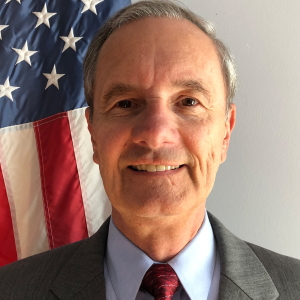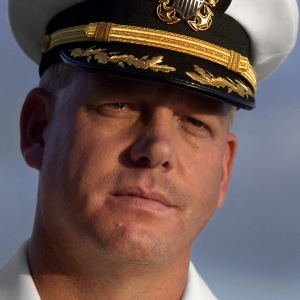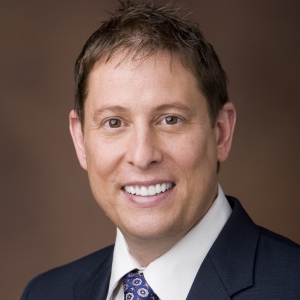Captain Larry Brudnicki Speaker Biography
U.S. Coast Guard Captain and Inspiration for the Motion Picture The Perfect Storm
Captain Larry Brudnicki led two dramatic rescue missions during the worst weather in 100 years, dubbed “The Perfect Storm.” This harrowing story of real people battling for survival on a sea “gone wild” became a best-selling book and a top-grossing film The Perfect Storm starring George Clooney and Mark Wahlberg.
The Perfect Storm
Larry Brudnicki’s experience as the real-life Captain of the Coast Guard ship that performed two dramatic rescues during the Perfect Storm amount to only 100 hours of a 30-year career of assessing risks, making decisions and inspiring teamwork. Captain Brudnicki was the Commanding Officer of the USCGC TAMAROA (WMEC-166), New Castle NH during “The Perfect Storm”. During his tour, TAMAROA had more fishing vessel seizures than the rest of the Coast Guard Atlantic fleet added together, and participated in Haitian Migration Interdiction Operations when the Coast Guard was recovering 1500 Haitians per day.
“You blended humor and a vital sense of reality to the importance of readiness in accomplishing our mission. We were sitting on the edge of our seats. You helped make our Conference a phenomenal success.” – DoD Pharmacy Board of Directors
Coast Guard Experience
His first assignment was on board the USCGC MADRONA (WLB-302), Portsmouth, VA where he served as Communications Officer and then as Operations Officer. At the age of 23, he was assigned as Commanding Officer of the USCGC CAPE CURRENT (WPB-95307), Savannah, GA from 1973 to 1975. He attended Wesleyan University where he earned a Master’s Degree in Physical Science to prepare him for an assignment as a Physics Instructor at the US Coast Guard Academy in New London, CT. In his spare time, he earned a Master’s Degree in Physics from the University of Connecticut, Storrs, CT. He served as the Executive Officer of the USCGC MARIPOSA (WLB-397), Detroit, MI, from 1980 until 1982. He was then assigned as the Chief, Minor Aids to Navigation Section, Ocean Engineering Division at Coast Guard HQ, Washington, DC and led the team of project engineers that gained the Coast Guard the reputation for being the world leader among the 200 member countries of the International Association of Lighthouse Authorities for using Solar Panels to power aids to navigation in the marine environment. As a result of this success, he was invited to serve as a consultant to the Panama Canal Commission to help them begin converting their aids to navigation to solar power.
“You spoke with a rare eloquence, conviction and sincerity. You truly inspired and motivated our managers and supervisors.” – Director Facilities Management, Memorial Hospitals Association
As the Engineer Officer of the Armed Forces Inaugural Committee from 1984 to 1985 for the Presidential Inauguration of Ronald Reagan, Captain Brudnicki planned, coordinated and executed all inaugural activities that required engineering support. He then served as the Commanding Officer of the USCGC BRAMBLE (WLB-392), Port Huron, MI, from 1985 until 1988. BRAMBLE produced the first two Waterways Management Analysis Studies in the Coast Guard, and while deployed from the Great Lakes to the Caribbean, had 3 drug seizures and assisted with another 3 drug seizures — netting 100,000 pounds of marijuana. His next tour of duties took him to the 17th Coast Guard District, Juneau, Alaska where he served as the Chief of the Aids to Navigation and Waterways Management Branch from 1988 until 1991. In 1993 he moved to San Diego, CA where he served as Commander, Coast Guard America’s Cup Patrol. Captain Brudnicki coordinated the efforts of 80 federal, state and local government agencies during the 1995 America’s Cup in San Diego. Captain Brudnicki was the Commanding Officer of the USCGC CHASE (WHEC-718) from 1995 to1997. For his final deployment, CHASE joined a Navy Destroyer Squadron to conduct training with foreign countries in Southeast Asia.
Captain Brudnicki retired from the Coast Guard in March 2002 after 30 years of active duty. He reported to his last assignment as the Chief of Operations, 11th Coast Guard District, Alameda, CA in August 1997 where he supervised more than 15,000 Search & Rescue cases, which saved 1,600 lives and property valued at $135 million. He also supervised the search for survivors of the Alaska Air Flight #261 tragedy. He had tactical control of ships and aircraft that seized more than 150 tons of cocaine, including the ten largest cocaine seizures in the year 2000 and again in 2001. He also had tactical control of the ships and aircraft that interdicted 2,800 illegal migrants from the People’s Republic of China, Ecuador and Mexico.
Awards and Recognition
Captain Brudnicki holds a Merchant Marine Master’s License, and is a member of the National Speakers Association. His awards include the Legion of Merit, the Coast Guard Medal “for heroism”, the Defense Meritorious Service Medal, the Meritorious Service Medal (two awards), the Coast Guard Commendation Medal (four awards), the Air Force Commendation Medal, the Coast Guard Achievement Medal and the Humanitarian Service Medal (two awards).
Education
Captain Brudnicki graduated from the U.S. Coast Guard Academy in 1972, where he earned a Bachelor’s degree in Engineering.
Book
Perfect Storm Keynote Speaker Captain Larry Brudnicki believes that great leaders are not risk takers, but risk managers. With the experience and first-hand knowledge, he developed his book Real World Management Strategies That Work. Each chapter of the book builds into a cohesive strategy covering essential topics from recruiting to leading to selling — all laced with real-world examples and practical applications.
Now that he no is longer paid to get cold and wet, Captain Brudnicki uses the experience he gained from leading successful high-risk missions with international visibility and what he learned investigating accidents of others who were not so successful to deliver a message of leadership, teamwork and risk management to corporations, associations and organizations so that they can implement the steps necessary for success while avoiding the pitfalls.
Captain Larry Brudnicki Speaking Topics
The Perfect Storm - Courage Under Pressure
A powerful and inspirational keynote that relates Captain Brudnicki's legendary experiences on the high seas. Ride with him as he relives the dramatic story of two daring rescue missions during the worst weather in more than 100 years! Learn how courage and leadership helped him to survive in the hostile environment of "The Perfect Storm!"
Leadership Secrets from the Perfect Storm:7 Steps to Making the Right Decision Every Time
Against the backdrop of "The Perfect Storm," this keynote provides the perfect balance between inspiration and application. The audience will see the 7 Steps in action along with examples of the courage, leadership and teamwork that are necessary to triumph in our uncertain business climate. Through practical lessons learned from his experiences, the audience acquires powerful tools to make the correct decisions even in the most difficult of circumstances.
Setting and Achieving Goals as a Team:10 Steps to Implement and 10 Pitfalls to Avoid
The dynamics of goal setting for a team is much different than it is for an individual due to the interaction between the team members. The audience will gain insight into why the team and its leader must create the right atmosphere, the importance of acting with the power of focus, and what the organization must do to provide the right environment. When the team implements the right steps and avoids the pitfalls, their chance of achieving their goals increases exponentially.
Managing Risk in Turbulent Times
This presentation is the perfect follow-on to the keynote: Leadership Secrets from The Perfect Storm - 7 Steps to Making the Right Decision Every Time. By using examples from other extraordinary missions he led, Captain Brudnicki goes into greater depth to illustrate the 7 Steps for assessing risk and managing projects. The audience will see how this process can be used to make decisions about new ventures, improve project management, and make clear, competent assessments of daily operations. Risk cannot be eliminated, but it can be managed.
Application Session: Managing Risk in Turbulent Times
This half day session will use case studies and examples from your company or organization to see the 7 Step Risk Management Ð Decision Making process in action. Audience members will gain hands-on experience assessing risk by using examples pertinent to their jobs. Participants will learn to become more comfortable making difficult decisions even in situations they can't control or when they don't like their options.
Captain Larry Brudnicki Books







